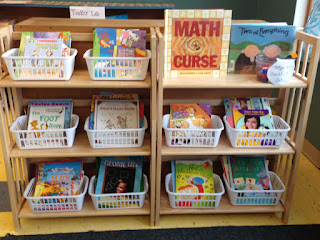In this unit, the second grades have been exploring 2-dimensional and 3-dimensional shapes and their characteristics and attributes. Their focus has been on identifying, comparing and sorting through 2-D and 3-D shapes, with much focus on rectangles and rectangular prisms.
One of the ways children learn and connect with these mathematical concepts is through literature. Children's literature is used regularly in second grade in order to explain a mathematical concept, provide meaningful context for mathematical content, review a skill, or to simply increase interest level. Our discussions always come back to the idea that math is used all around us. When a child can make a math connection in a story, math becomes more interesting. For children who enjoy reading, but are apprehensive about math, connecting math to literature can boost confidence. And for those who already love math can learn to appreciate stories in an entirely new way.
One book connected to our geometric work is the fun and engaging story, Sir Cumference and the Sword in the Cone. In this story, King Arthur has issued a challenge to the knights in the form of a riddle. Whoever solves the riddle and finds the sword, Edgecalibur, will be the future king. Two friends are given clues which lead them to Geo and Sym of Metry who help them to make the clue's flat figures into 3-D shapes. With the clue to guide them, the two discover Euler's Law which is the idea that if you add the number of faces on a geometric solid to the number of its points and subtract the number of it's edges, the answer will always be 2. This worked for all of their objects except for the cone, which lead them to dig and discover Excelsior! The story presented many mathematical problems the children enjoyed solving, and the 2 and 3-Dimensional illustrations inspired the group to build and then illustrate their own 2-dimensional and 3- dimensional castles.
Other favorites include The Greedy Triangle and the nonfiction text, Geometry which both capture the idea that shapes are all around us. It's exciting for children to experience math in a different day and to feel the joy and satisfaction that reading brings.




























